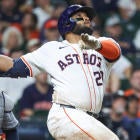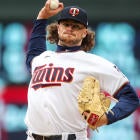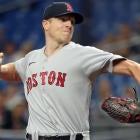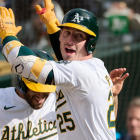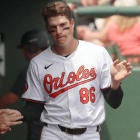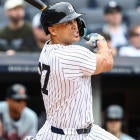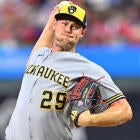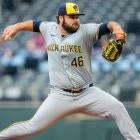2016 Rankings: C | 1B | 2B | 3B | SS | OF | SP
One of the biggest storylines of the 2015 season was the surplus of talent at third base. Between the emergence of Manny Machado, Nolan Arenado and Todd Frazier as elite contributors in Fantasy and introduction of Kris Bryant, Miguel Sano and Maikel Franco to the majors, the position became one of enviable depth, rivaling that of even first base.
So naturally, the same will be true in 2016, right? Well ...
Not every player with third base eligibility was actually playing third base this year, at least not enough to remain eligible there next year, and it includes some notable names.
One I've already mentioned: Sano, who'll be DH-only in 2016. Otherwise, he'd be a top-10 third basemen, ranking not too far behind Kris Bryant at No. 5.
And he may not even be the most notable of this season's third basemen confined to DH next season. Alex Rodriguez is in the same boat, which will make passing him up because of his age a little bit easier. Feeling good about Chris Davis again after his second-half power binge? That's great as long as you intend to make him your first baseman or outfielder next year. And if you were planning to target Joey Gallo as a post-hype sleeper, well, better keep a spot open in the outfield. Third base isn't happening for him.
It doesn't mean the position is weak or that you'll have to overextend yourself on Draft Day to have a viable option there, but it's something to keep in mind as you start planning for 2016.
Top 10 third basemen for 2016:
1. Josh Donaldson, 3B, Blue Jays
2. Manny Machado, 3B, Orioles
3. Nolan Arenado, 3B, Rockies
4. Kris Bryant, 3B, Cubs
5. Todd Frazier, 3B, Reds
6. Matt Carpenter, 3B, Cardinals
7. Anthony Rendon, 2B/3B, Nationals
8. Kyle Seager, 3B, Mariners
9. Maikel Franco, 3B, Phillies
10. Adrian Beltre, 3B, Rangers
To me, the elite tier of three is pretty clear cut, with Bryant being the most likely to join them in 2016. Frazier was a fourth before his miserable second half, but he showed enough life toward the end for me to drop him only the one spot.
The one quibble about the order of the five would be Machado ahead of Arenado, especially with Arenado's ridiculous September fresh on everyone's mind, but with superior plate discipline, some modest base-stealing ability and the previously unexplored possibility of him gaining shortstop eligibility down the road, I perceive Machado to have the higher ceiling. Both are first-rounders, along with Donaldson, as far as I'm concerned.
Carpenter and Rendon are going to be two of the most interesting players in next year's draft and form kind of an oddball tier between the elite and the also-rans at third base, though in Rendon's case, it's not entirely clear that you'll be drafting him to play third base. In fact, just earlier this year, we were drafting Rendon in the second round, and the way he rebounded the last two months after an injury-plagued start to the year, I almost feel like I'm shortchanging him by ranking him behind Carpenter.
But Carpenter's power breakthrough this year makes his potential especially exciting. Maybe the increased strikeout rate and reduced batting average were side effects of that, but if he can deliver the best of both worlds -- the high contact rate we've seen in the past and the newfound power -- he could get back in the MVP discussion. No matter which version of Carpenter shows up, he's close enough to Rendon to justify the risk.
"Risk" is among the last words you'd associate with Seager, who had his fourth straight season of more or less the exact same numbers. And those numbers -- a .270ish batting average and 25 home runs or so -- will keep you content at third base. They won't set you apart, so he's a little boring in that regard, but you really can't go wrong with him.
A slightly more exciting but less proven version would be Franco, who was notably better than Seager in his 296 at-bats before suffering a season-ending wrist injury but who had also just begun to come down to earth after a prolonged hot streak. Who knows if he would have sustained that pace all season? It's fair to say his upside doesn't compare to Bryant, so in the end I think he and Seager have the same formula for success: make enough contact to stand out from the other 25-homer-per-year types at the position.
Of course, that's also true for Beltre. He's now part of that lesser tier, which is only natural considering he'll be 37 next year. We kept thinking his numbers would fall off a cliff at some point, and they still haven't, but a second straight year of declining power -- the second even worst than the first -- pretty much tells the story. The good news is that, like Seager and Franco, Beltre makes contact at a high enough rate that he doesn't have to hit 30 homers to make a significant contribution in Fantasy. He may have the most downside of the three, though, given his age.
But it's more of a group of four than three, really, as we'll see with the next 10.
Next 10 third basemen for 2016:
11. Mike Moustakas, 3B, Royals
12. Evan Longoria, 3B, Rays
13. Jung Ho Kang, 3B/SS, Pirates
14. David Wright, 3B, Mets
15. Hector Olivera, 3B, Braves
16. Matt Duffy, 3B, Giants
17. Daniel Murphy, 2B/3B, Mets
18. Trevor Plouffe, 3B, Twins
19. Yangervis Solarte, 1B/3B, Padres
20. Justin Turner, 3B, Dodgers
Compare Moustakas' numbers to Seager's, and you'll see that they were more or less the same player this year. Seager had more home runs, but he also played more games. Moustakas beat him in the percentages. Of course, Seager has done it four years straight while Moustakas was in danger of losing his job at the start of the year. I also believe we saw the full extent of Moustakas' potential this year while Franco and Beltre do have some hope for more. All four project to have about the same numbers, but when you factor in two of the qualities that projections can't effectively gauge, safety and upside, Moustakas doesn't measure up.
Longoria, though clearly not the stud he once was, rounds out what I consider to be the trustworthy mixed-league options at the position, bringing the number to between 11 and 12 depending what position Rendon is drafted to play. Kang would have been another trustworthy option, perhaps even top-10, if not for his late-season knee injury. His shortstop eligibility could still make him a game-changer in Fantasy, but you obviously can't count on him at the start of the year. In other words, third base could get tight in a 12-team league, particularly one that employs a corner infield slot, so if you don't make it something of a priority on Draft Day, you'll either have to roll the dice on Wright and Olivera -- two lottery-ticket picks at the position -- or settle for the comparative mediocrity of Duffy, Murphy or Solarte.
Here's where the Giants fan chimes in: Now, wait a minute. Duffy is just as big a part of the NL Rookie of the Year race as Kang is. OK, but again, Kang is shortstop-eligible. And to use the other end of the spectrum as a basis for comparison, what makes Duffy so much better than Murphy and Solarte? He has the worst walk rate of the three, the worst strikeout rate of the three and the worst ISO of the three (rate of extra-base hits, in layman's terms). He may have the highest batting average, but given those other numbers, he has the lowest potential batting average of the three. All things considered, he's lucky to rank as high as he does.
So why behind Wright and Olivera? Well, Wright's upside speaks for itself. It's just that no one can say for sure how long or how often his back condition will allow him on the field. Olivera's upside is completely theoretical, but his role is secure and the scouting reports make him out to be something special once he gets his legs under him. Better to roll the dice than settle for replacement-level in a standard mixed league.














